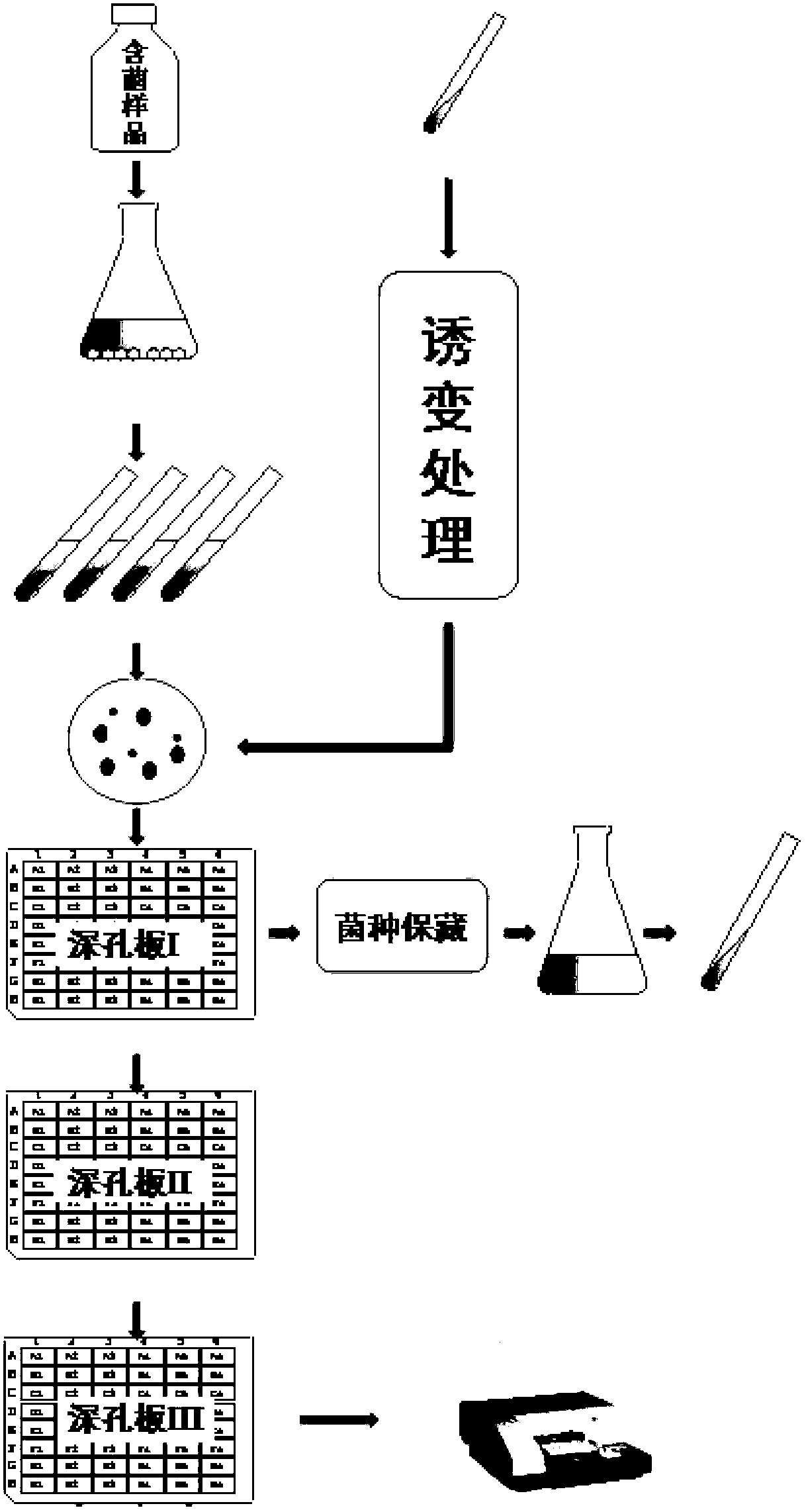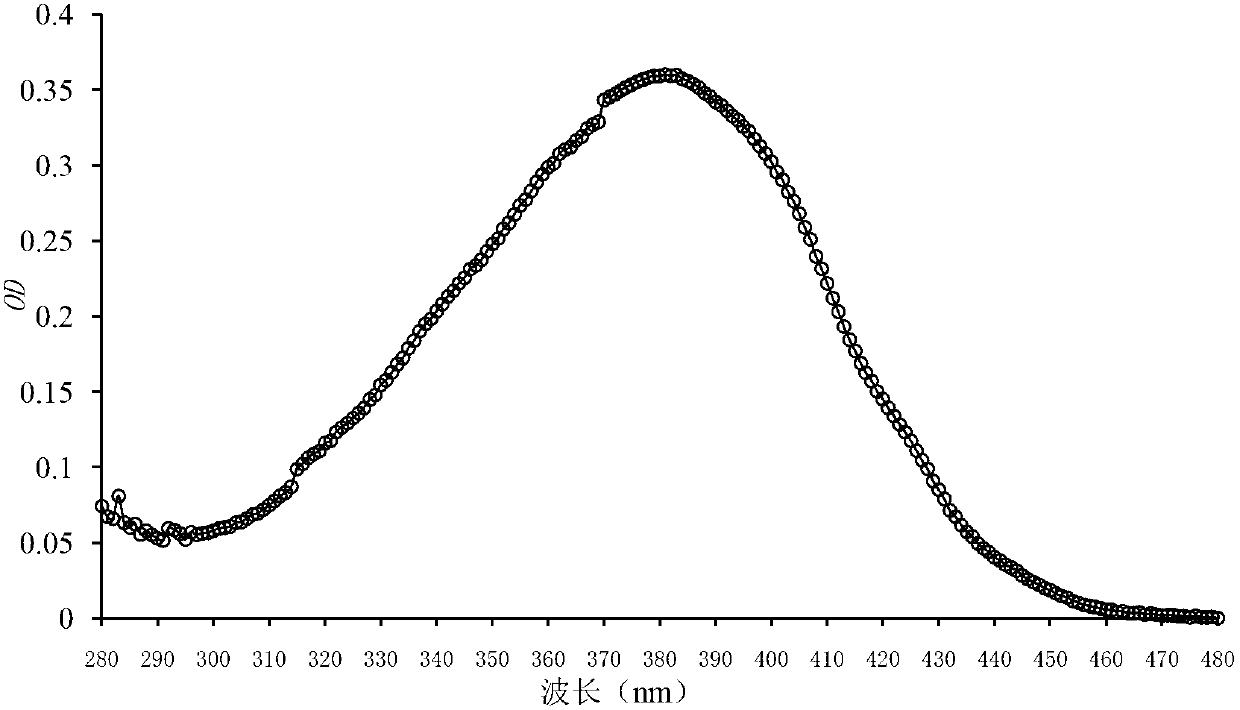High throughput screening method of aminopeptidase and high-yield strain thereof
A screening method, aminopeptidase technology, applied in the fields of microbial breeding, enzyme engineering and fermentation engineering, can solve the problems of long cycle, heavy workload, high cost, etc., and achieve less medium and reagents, fast speed, and reduced labor. Effect
- Summary
- Abstract
- Description
- Claims
- Application Information
AI Technical Summary
Problems solved by technology
Method used
Image
Examples
Embodiment 1
[0037] Comparison of the maximum absorption wavelength of the enzyme plate method and the conventional p-nitroaniline method.
[0038] Prepare 400 μmol / L p-nitroaniline, respectively use microplate plate and microplate reader method, cuvette and ultraviolet-visible spectrophotometer, and scan continuously from 280nm to 480nm. To plot the absorbance curve for p-nitroaniline, see figure 2 and image 3 . Depend on figure 2 and image 3 It can be seen that the maximum absorption peak of the ELISA method is consistent with that of the conventional p-nitroaniline method, both at about 380 nm, and the absorbance is also consistent.
Embodiment 2
[0040] High-throughput assay of methionine aminopeptidase enzyme activity.
[0041] Add 40 μL of ammonia-ammonium chloride buffer (0.05mol / L, pH8.0) and 20 μL of methionine p-nitroaniline substrate solution (6mmol / L) into the microwells of the microplate, and then add 20 μL of the crude enzyme solution to be tested that has been appropriately diluted, and 20 μL of distilled water for the blank control instead of the crude enzyme solution. Cover the lid and react in a water bath at 60°C for 10 min, and immediately add 120 μL of 50% acetic acid solution to terminate the reaction. Measure the absorbance with a microplate reader preferably at 380nm, and calculate the enzyme activity of the crude enzyme solution according to the standard curve and the dilution factor of the crude enzyme solution. Definition of enzyme activity: at a temperature of 60°C, the amount of enzyme needed to hydrolyze methionine-p-nitroaniline to produce 1 μmol of p-nitroaniline per minute is defined as on...
Embodiment 3
[0045] Comparison of enzyme activity determination results by ELISA plate method and conventional p-nitroaniline method.
[0046] Prepare p-nitroaniline standard solutions with concentrations of 150 μmol / L, 200 μmol / L, 250 μmol / L, 300 μmol / L, 350 μmol / L and 400 μmol / L respectively, with 0 content as the control, at the wavelength of 380 nm, use enzyme-labeled The content of p-nitroaniline was determined by plate method and conventional p-nitroaniline method. Take the absorbance as the abscissa, and the p-nitroaniline concentration as the ordinate, draw a standard curve, and the standard curves of the two methods are as follows: Figure 4 , Figure 5 . Depend on Figure 4 , Figure 5 As shown, the standard curve of p-nitroaniline by the microtiter plate method satisfies the regression correlation coefficient above 0.999, and the corresponding p-nitroaniline concentration at the two endpoints of the regression line is 20.720-55.252 μg / mL, which is consistent with the convent...
PUM
 Login to View More
Login to View More Abstract
Description
Claims
Application Information
 Login to View More
Login to View More - Generate Ideas
- Intellectual Property
- Life Sciences
- Materials
- Tech Scout
- Unparalleled Data Quality
- Higher Quality Content
- 60% Fewer Hallucinations
Browse by: Latest US Patents, China's latest patents, Technical Efficacy Thesaurus, Application Domain, Technology Topic, Popular Technical Reports.
© 2025 PatSnap. All rights reserved.Legal|Privacy policy|Modern Slavery Act Transparency Statement|Sitemap|About US| Contact US: help@patsnap.com



